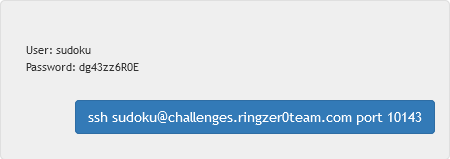RingZer0 CTF - Classic Sudoku
The challenge
In this challenge we have to login in via ssh to get the task. Let’s see what it is:
1
ssh -p 10143 sudoku@challenges.ringzer0team.com
We have to solve 3x3 Sudoku challenge in less than 10 seconds. I don’t think human can do it easily, so we need some coding here and we will use Python3. Let’s solve it step-by-step 👨💻
Configuration
Preparation
It was so hard to find a library which would work correctly in our case. After some hours of exploring, I’ve found that we can interact with a child process created by a pty and os libraries. I thought to write sudoku solver myself, but luckly for us there is a library that can do it - py-sudoku. We install it in terminal with command below:
1
pip3 install py-sudoku
Libraries and globals
Now the code starts:
1
2
3
4
5
6
7
8
9
10
11
12
13
14
15
16
17
18
import os
import pty
from sudoku import Sudoku
HOST = 'challenges.ringzer0team.com'
PORT = '10143'
USER = "sudoku"
PASS = "dg43zz6R0E"
ssh_command = [
"/usr/bin/sshpass",
"-p",
PASS,
"ssh",
"-p",
PORT,
f"{USER}@{HOST}",
]
After imports we specify variables for login into ssh. Then, we specify list with command strings, we will use it later to create our child process.
We are using sshpass to provide the password in one command, I did it just to make things easier, never do it in real work.
Get the challenge
Connect via ssh
After preparation, we are creating a child process, which will connect to the server via ssh. We use fork function from pty library to get the process, then we execute our ssh_command and start interact with it. We get raw_challenge string and parse it by creating the list, slicing it and converting into a string again.
1
2
3
4
5
6
7
8
9
10
11
12
13
14
pid, child_fd = pty.fork()
if not pid:
os.execv(ssh_command[0], ssh_command)
# Skip pty message
output = os.read(child_fd, 1024)
raw_challenge = os.read(child_fd, 1024).decode()
raw_challenge = raw_challenge.split("\n")
challenge = "\n".join(raw_challenge[3:22])
board = parse_sudoku(challenge)
We interact with child process by reading it STDOUT with os.read and writing into STDIN by os.write. We skip ssh’s message about PTY by reading 1 line.
Parse the challenge
To work with py_sudoku we have to convert challenge string into two-dimensional list. It is a requirement, I’ve made a function called parse_sudoku to do it.
1
2
3
4
5
6
7
8
9
10
11
12
13
14
15
def parse_sudoku(plain_text):
result = []
lines = plain_text.split("\n")
lines = lines[1::2]
for line in lines:
res_line = []
for num in line.split("|"):
if num == " " * 3:
res_line.append(0)
elif num.strip().isdigit():
num_ = int(num.strip())
res_line.append(num_)
result.append(res_line)
return result
We use slicing to get lines one by one. Then, we split the line and checking if there is 3 spaces or a number. 3 spaces are equal to 0 here.
Solve the Sudoku
Just solve it
The solution is really simple. We already have what we need, just provide the board to Sudoku class with 3x3 size and call the solve function. The library presents the solution in many formats, but list is the most preferred for us, so we specify board attribute. Then, we have to convert the solution into right format and write it to STDIN of our child process.
1
2
3
4
5
6
7
8
9
10
11
12
13
14
puzzle = Sudoku(3, 3, board=board)
solution = puzzle.solve().board
answer = []
for line in solution:
line_ = map(str, line)
answer.append(",".join(line_))
answer = ",".join(answer) + "\n"
os.write(child_fd, answer.encode())
# Skip our written answer
os.read(child_fd, 1024)
flag = os.read(child_fd, 1024).decode()
print(flag)
We have to skip 1 line of STDOUT because there is our answer there. I don’t know why our STDIN appears in our STDOUT…
Run the script
Let’s run our script and get the flag.
It worked! Paste the flag on the site to get your points!
You can find the full solution code below:
1
2
3
4
5
6
7
8
9
10
11
12
13
14
15
16
17
18
19
20
21
22
23
24
25
26
27
28
29
30
31
32
33
34
35
36
37
38
39
40
41
42
43
44
45
46
47
48
49
50
51
52
53
54
55
56
57
58
59
60
61
62
63
64
65
66
67
68
69
70
import os
import pty
from sudoku import Sudoku
HOST = 'challenges.ringzer0team.com'
PORT = '10143'
USER = "sudoku"
PASS = "dg43zz6R0E"
ssh_command = [
"/usr/bin/sshpass",
"-p",
PASS,
"ssh",
"-p",
PORT,
f"{USER}@{HOST}",
]
def parse_sudoku(plain_text):
result = []
lines = plain_text.split("\n")
lines = lines[1::2]
for line in lines:
res_line = []
for num in line.split("|"):
if num == " " * 3:
res_line.append(0)
elif num.strip().isdigit():
num_ = int(num.strip())
res_line.append(num_)
result.append(res_line)
return result
def main():
pid, child_fd = pty.fork()
if not pid:
os.execv(ssh_command[0], ssh_command)
# Skip pty message
output = os.read(child_fd, 1024)
raw_challenge = os.read(child_fd, 1024).decode()
raw_challenge = raw_challenge.split("\n")
challenge = "\n".join(raw_challenge[3:22])
board = parse_sudoku(challenge)
puzzle = Sudoku(3, 3, board=board)
solution = puzzle.solve().board
answer = []
for line in solution:
line_ = map(str, line)
answer.append(",".join(line_))
answer = ",".join(answer) + "\n"
os.write(child_fd, answer.encode())
# Skip our written answer
os.read(child_fd, 1024)
flag = os.read(child_fd, 1024).decode()
print(flag)
if __name__ == "__main__":
main()
Conclusion
I’ve spent a lot of time to find a way to interact with ssh session as a pseudo-terminal subprocess. I’m really glad to learn it. There are so much libraries written in Python. I think you can find everything written in this language 😂.
Thank you for reading, I hope it was useful for you ❤️



